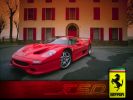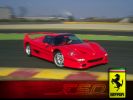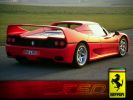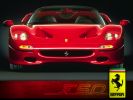The Supercar Resource
1997 Ferrari F50
Pictures and Specifications
|
Click on above picture to view wallpaper-size picture. |
||
Ferrari F50
In its early days, over 50 years ago, Ferrari built cars which could be used, with only a few minor alterations, for Formula 1 or Sportscar events or everyday on the street. However, as Formula 1 cars evolved, it became impossible for someone who was not a team driver or a collector capable of passing a series of private tests on the track, to take the wheel of a racing Ferrari. Ferrari decided to again give all its clients the chance for this experience. The F50 was the response to this technological challenge.
Thanks to the research made possible by Ferrari's vast experience in this field, producing over 45 racing models and over 120 GT and Sports models, the F50 was built to the same tolerances and with the same integrity as a Formula 1 car. The carbonfiber monocoque that enclosed the aeronautical rubber fuel tank, the V12 engine that acted as a load-bearing structure for the transaxle-rear suspension assembly, the pushrod suspension, and separate hand-braking system are formed on the basic principles of a racing car projected into the dimension of normal, safe use in all situations. The result was a car with a specific power output of 109 HP/litre and an extraordinary chassis that combined unbeatable performance with exact handling and ultimate safety even in unexpected or extraordinary circumstances.
The body was built entirely from composite materials with carbon fiber, Kevlar and Nomex honeycomb molded in one of five available colours: red, red Barchetta, yellow, black and grey Nurburgring. On the Berlinetta version, the function of the integral hard top was to complement the structural elements. On the Barchetta version, the bodywork element incorporated the anchor points for two roll hoops. The engine was visible through part of the transparent, vented engine cover.
The chassis of the F50 was made entirely of carbon fibre, weighing 225 lbs and offering a torsional rigidity of 25,677 lbs-ft/°. Like a Formula 1 car, occupants sat in the central tub formed by the chassis, and the aeronautical rubber fuel cell was located in a protected position between the passenger tub and the engine and rear suspension. The result was in advanced driving position, with a front to rear weight distribution of 42:58. A load-bearing element, the F50's engine acted as a support for the suspension, rear bumper and bodywork elements. To guarantee perfect suspension operation, the engine-transaxle assembly was rigidly attached to the chassis.
The suspension and engine-gearbox assembly were mounted via low-fatigue light alloy inserts co-polymerized to the chassis. To optimize the structure that made up the fulcrum of the entire system, even from the safety viewpoint, finite element calculation techniques were employed, using programmes that included sandwich elements and multi-ply shells, typical of laminated composite structures. Engineers and designers had to solve problems of the long-term stability of dimensional and structural elements. Tests were carried out on computerized vibration benches.
. . . ( collapse )Source:
| Performance | |||
| Top Speed | 203.0 mph / 326.7 kph | 0-60 mph | 3.6 seconds |
| Skidpad | 1.03g | 0-100 mph | 8.0 seconds |
| EPA City / Highway | Not Available | 0 - ¼ Mile | 12.1 seconds |
| Drag Coefficient | Not Available | 0-100-0 mph | Not Available |
| Slalom | Not Available | Stopping Distance | Not Available |
| General Information | |||
| Base Price | $480,000 | Production | Not Available |
| Powertrain Layout | Mid Engine / RWD | Steering | Rack & Pinion with Power Assist |
| Body Material | Honeycomb Carbon Fibre & Kevlar | Front Wheels | 18 x 8.5 in. / 45.7 x 21.6 cm |
| Brake Type | Vented Discs | Rear Wheels | 18 x 13 in. / 45.7 x 33 cm |
| Brake Size | F: 14 in. / 356 mm R: 13.2 in. / 335 mm |
Front / Rear Tires | P245/35ZR-18 / P335/30ZR-18 |
| Engine | |||
| Configuration | 65ø V12 | Displacement | 4,699 cc / 286.8 cu in. |
| Valvetrain | DOHC 5 / cylinder | Bore | 3.35 in. / 85.0 mm |
| Power | 513.1 bhp @ 8,500 rpm | Stroke | 2.72 in. / 69.0 mm |
| Torque | 347.0 ft-lb. @ 6,500 rpm | Compression Ratio | 11.3:1 |
| Redline | 8,500 rpm | Final Drive Ratio | 3.70:1 |
| Transmission | 6-speed Manual | Gear Ratios | 2.79:1, 2.00:1, 1.59:1, 1.32:1, 1.11:1, 0.90:1 |
| Dimensions | |||
| Wheelbase | 101.6 in. / 2,581 mm | Length | 176.4 in. / 4,481 mm |
| Front Track | 63.8 in. / 1,621 mm | Width | 78.2 in. / 1,986 mm |
| Rear Track | 63.1 in. / 1,603 mm | Height | 44.1 in. / 1,120 mm |
| Weight Distribution | Not Available | Curb Weight | 2,709 lb. / 1,229 kg |








